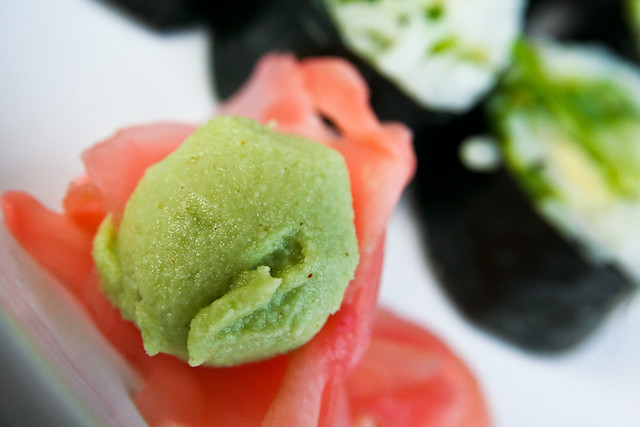
A silent alarm that emits a stinging smell of wasabi may be life-saving for the hard of hearing.
You might be familiar with the green horseradish paste that comes with sushi: wasabi. Scientists in Japan used the pungent smell of wasabi as an alarm to alert people of a fire. This idea seems incredible, but it was motivated by efforts to create an alarm system effective for people with hearing difficulties.
Japan’s news station NHK reported the progress of this project that has started to produce hopeful results as early as 2008 (for Japanese readers, here is the original NHK article). A mix of wasabi and other mints create a bitter and stinging smell that stimulates the mucous membrane within the nose. This smell is collected into a pressurized can. When the fire alarm bell rings, the machine detects the sound and relays an electric signal to trigger the release of the smell.
Medical equipment manufacturers collaborated to produce this wasabi alarm. The Shiga University of Medical Science conducted experiments to test the efficacy of this wasabi alarm to wake up people who are sound asleep. For a subject pool of 14 males and females in their 20s to 40s, the researchers found that except for one person who had a stuffy nose, all other 13 people woke up within 2 minutes. Four of these subjects had a hearing impairment, and including one who woke up within ten seconds, all woke up within thirty seconds. After experiencing the pungent smell, the test subjects strongly supported the implementation of this wasabi alarm device.
This invention received international attention in in 2011 when it received the Ig Nobel Prize, and was covered by news reports such as BBC and Reuters.

Other fire alarm systems made for deaf people have used light and vibrations but with mediocre success. Light is hard to notice while asleep, and vibrations require the machine to be worn by the person at all times to detect any movement. Researchers hope that this wasabi alarm system would be used effectively in conjunction with these earlier alarm systems.
“Achievements that first make people laugh, and then make them think” is the core principle of the Ig Nobel Prize. The humorous thought of a wasabi alarm in real life was hard to take seriously at first. However, it for sure caught my attention and made me evaluate the weaknesses of a sound-based alarm.
Prof. Makoto Imai is the leading founder of the wasabi alarm system. News of his recent presentation last week on the wasabi alarm made me revisit this research and its progress.
Despite it still being advertised for sale online (Tokyo Wax Co. Ltd., Yahoo, and Rakuten for example), perhaps the hype had died down and results of practical applications of this alarm have not been widely reported since 2011. Some skeptic bloggers noted that use is limited for economical reasons (one alarm costs close to $500) and maybe for the thought of being sprayed with a strong wasabi smell.
The wasabi alarm may still be far from implementation in public spaces. However, the finding that wasabi is effective to wake people from their sleep, and the innovative idea to add scent to alarms is valuable and makes me hopeful for future studies.
Prof. Makoto Imai is currently a Lecturer at Shiga University of Medical Science in Japan.
This article was originally written for the UBC Communicating Science Blog.

This is a super cool idea. We humans have done such a poor job of exploiting our sense of smell.. This alarm reminds me of a watch that ‘smells you the time’: http://www.fastcodesign.com/3026769/a-watch-that-smells-you-the-time
Pretty fun stuff on here Maki!
Linking smell to time is another incredible idea! It’s true — we may use smell to tell something is rotting or to judge a good recipe — but creating and utilizing these smells for practical use seems rare.
Thanks a lot for sharing this, Kurtis! I’m enjoying your “Scope of Science” blog a lot.
Dear Maki,
I came across your blog while searching about the wasabi alarm. I am more interested in the human exposure experimental details that are briefly mentioned in the patent application and other places. I would like these details of experiments to assess safety/risk of allyl isothiocyanate compound that is used in the alarm. I was unsuccessful in finding contact details of the authors.
I noticed that you have more details than anywhere I could find. Especially, regarding how many people were exposed etc. Somehow, I want to get hands on those details. Can you forward me the report/publications that has these details or provide contact information for Prof. Makoto Imai? Thank you so much, and would appreciate your help.
My contact information
Puttappa.dodmane@cdpr.ca.gov
Dear Dr. Dodmane, Thank you for reaching out, and I have replied to you directly. I wish you luck with your study!
Wow, what a unique kinds of alarm it is. A pungent spell as an alarm, really it deserves rewards for this idea.